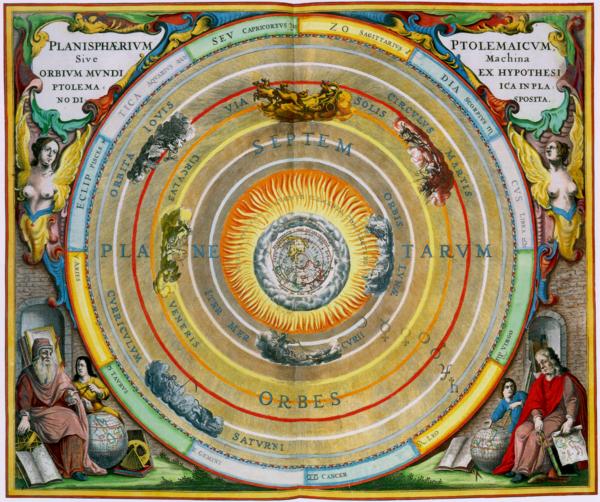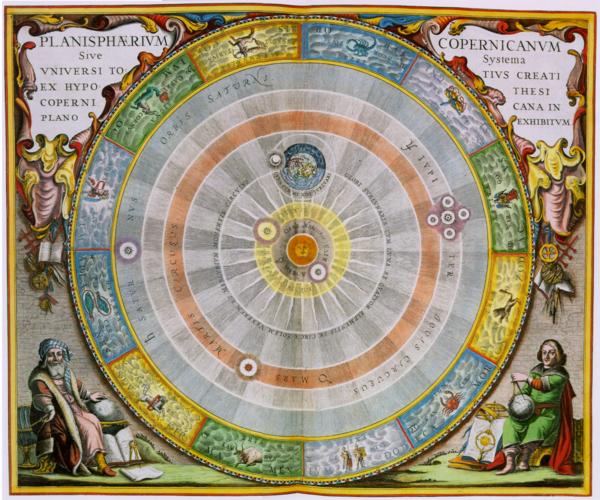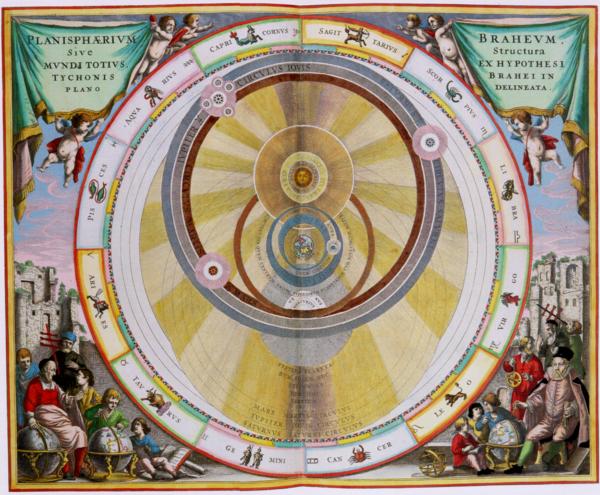
published 1661 (Amsterdam).
Andreas Cellarius Palatinus published his Atlas Coelestis seu Harmonica Macrocosmica 1661 in Amsterdam. The 29 charts hand-coloured maps are probably the most artistic renditions of the scientific ideas of his time about the planetary system.
The three examples selected here demonstrate the long period over which alternative models of the solar system co-existed. (If the maps are too wide to be seen in one piece you can make the frame wider by moving its border.)
The first map is an illustration of the Ptolemaic system. The Earth, the centre of the planetary system, is shown in great detail, with the North Pole in the centre, America in the upper half and Europe and Africa in the lower half. A silver chariot on a silver-white circle indicates the path of the Moon, a golden chariot on a golden circle the path of the Sun. The planets are found on the remaining circles.

PLANISPHAERIUM PTOLEMAICUM Sive Machina ORBIUM MUNDI EX HYPOTHESI PTOLEMAICA IN PLANO DISPOSITA
Ptolemaic planisphere, or the engine of the circles of the World according to the Ptolemaic hypothesis, layed out in a plane
The second map is an illustration of the Copernican system. It has the Sun in the centre and lets the planets revolve around it on circles. The Earth is shown with its Moon and its path around the Earth. Jupiter is shown with four moons.

PLANISPHAERIUM COPERNICANUM Sive Systema UNIVERSI TOTIUS CREATI EX HYPOTHESI COPERNICANA IN PLANO EXHIBITUM
Copernican planisphere, or the system of the entire universe according to the Copernican hypothesis, displayed in a plane
The third map shows the compromise suggested by Tycho Brahe. It has the Earth in the centre; Sun and Moon circle the Earth but the other planets revolve around the Sun. Jupiter is again seen with four moons.

PLANISPHAERIUM BRAHEUM Sive Structura MUNDI TOTIUS CREATI EX HYPOTHESI TYCHONIS BRAHEI IN PLANO DELINEATA
Brahe's planisphere, or the structure of the entire World according to the hypothesis of Tycho Brahe, outlined in a plane
Various copies of Cellarius' work are still extant. The illustrations shown here are based on the copy in the National Art Library , Victoria and Albert Museum, London. Another copy is in the Charles A. Harrison Collection of Southeast Missouri State University, Cape Girardeau, Missouri, USA.